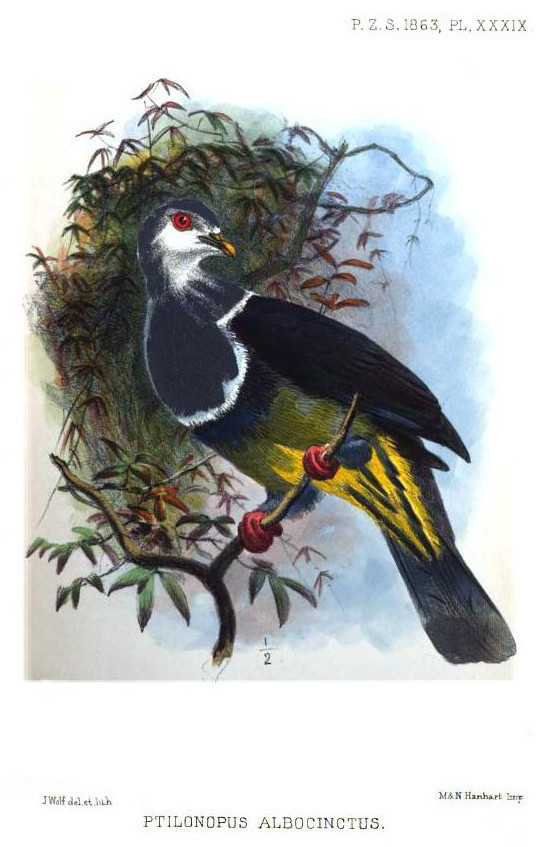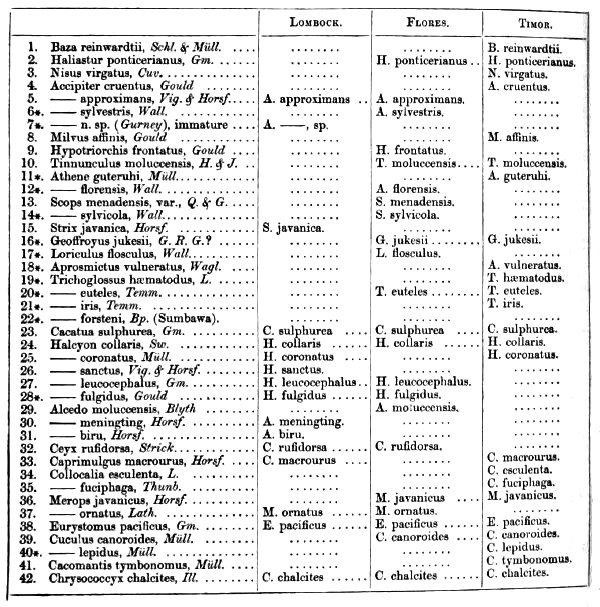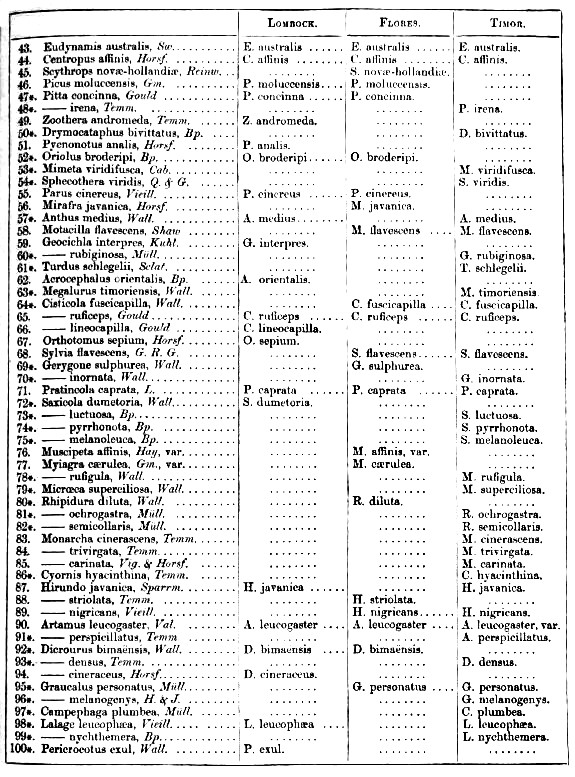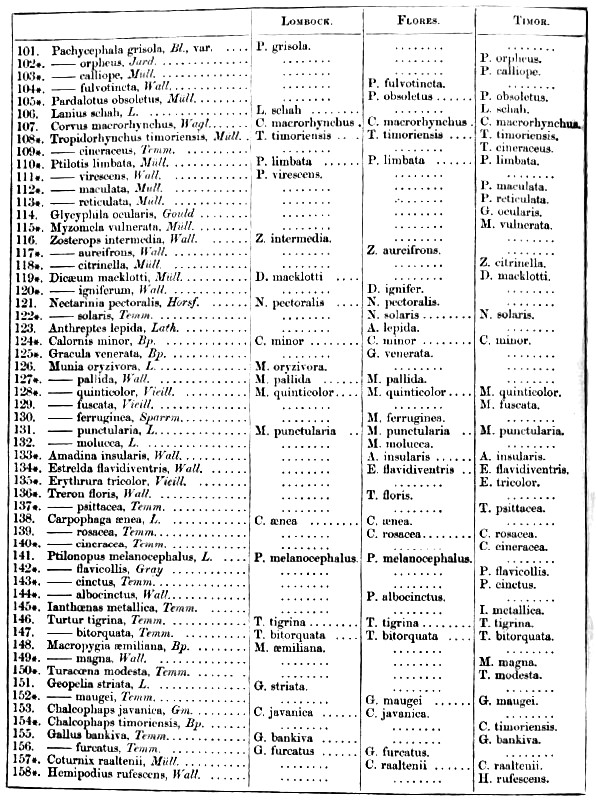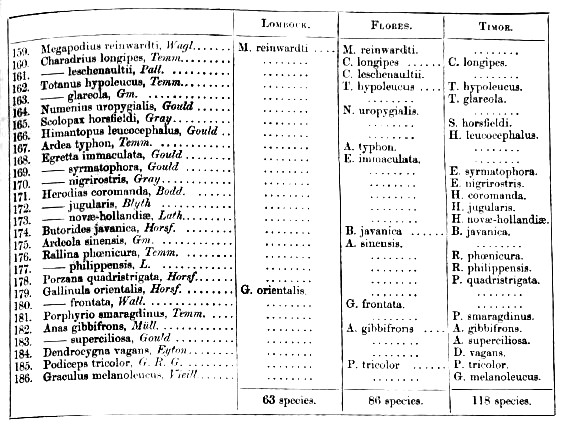|
Russel Wallace : Alfred Russell Wallace (sic) Flores, and Lombock, with Descriptions of the New Species (S85: 1863) (Plate XXXIX.) [[p. 480]] The chain of islands situated to the east of Java, and ending in Timor, forms a natural subdivision of the Malayan archipelago, being distinguished by peculiarities of physical geography as well as by a characteristic fauna. These islands all contain active volcanoes, and are for the most part of volcanic origin. Timor, however, which lies somewhat obliquely to the rest, consists in a great measure of ancient sedimentary rocks, which seem to have been exposed for long periods to volcanic convulsions, since they are everywhere shattered and distorted in a remarkable manner. All of these islands have a climate which differs from that of the rest of the archipelago in being remarkably dry; and this has produced a characteristic vegetation, in which spiny and prickly shrubs abound, while the dense luxuriant forests of the regions nearer the equator are quite unknown. The forest-trees of Timor are chiefly Eucalypti and Acacias, thinly scattered over bare and gravelly slopes; while it is only in the damper and more sheltered spots that patches of bush and thickets occur. I visited Timor twice, and collected for nearly five months in both the eastern and western districts, obtaining 112 species of birds. Ill health and wars between the Portuguese and the natives prevented me from going far into the interior, where, especially on the south coast, I have reason to believe many additional species might have been obtained. Six other birds are said to be from Timor, mostly collected by the naturalists of the Dutch Government expeditions, making a total of 118 species from this island. My assistant, Mr. Allen, collected for nearly four months in the large island of Flores, and obtained eighty-six species of birds; and I am not aware that a [[unnumbered page]]
[[p. 481]] single species was previously known from this locality. From the next island, Sumbawa, I have obtained no collections. A few are indicated by Bonaparte as existing in the Leyden Museum, the whole of which, with one exception only (Trichoglossus forsteni), are found in the adjacent islands. In the next island, Lombock, I collected myself for two and a half months, obtaining sixty-three species of birds. The island of Bali commences the Indian region of zoology, which we have not now to consider; but I may mention that, according to the Dutch naturalist Zollinger, its fauna is absolutely identical with that of Java. The total number of species known to inhabit this group of islands is 186. Taking into consideration the comparative sizes of the islands, the above numbers may be supposed to represent with tolerable fairness their respective bird populations, and will therefore furnish us with materials for some interesting comparisons. The Timorese subfauna, as we may conveniently name it, differs strikingly from the Moluccan in the absence of such genera as Lorius, Eos, Eclectus, and Lycocorax, and also of Tanysiptera, Alcyone, Criniger, and the subgenera Iotreron and Cyanotreron, all of which, though not peculiar to the Moluccas, are very characteristic of that group of islands. On the other hand, it shows a closer connexion with Australia than any other part of the archipelago, as evidenced by five genera, Sphecothera, Gerygone, Pardalotus, Glycyphila, and Amadina, which are found in this chain of islands, but do not pass into the Moluccas or Celebes. The number of species which appear to be restricted to the Timorese subfauna is eighty-one, many of which, however, are very slight modifications of Australian species. On the other hand, there is not a single genus confined to the group, or which can be said to have its metropolis in it--indicating that the fauna is strictly derivative, and of not very ancient date. In endeavouring to determine the origin of this fauna, we must eliminate those species and genera which, having a wide distribution and roaming habits, can give us little definite information. These are chiefly raptorial and aquatic birds, with a portion of the Passeres; and I find that fifty-seven species of this nature are identical with those of surrounding countries, while thirty-five more are representative species which cannot be referred to any one island rather than another for their probable origin. Deducting these ninety-two species, we have left a rather larger number of birds which we can trace directly either to Australia on the one side or to Java on the other. The species which appear to be confined to each island may be classed as follows-- Lombock 4, of which 1 genus is Australian, 1 genus Indian, showing that while there is a great preponderance of the forms of the Australian region in Timor, they decrease going westward, till in Lombock they are equalled by the Indian forms, The species which [[p. 482]] are identical with those of Java or Australia show the proportionate influence of the two countries in a yet more striking manner.
This table shows how two streams of immigration have entered the islands, the one from Java diminishing in intensity as it flowed on to Timor, the other from Australia diminishing in about the same degree towards Lombock. The total number of species which have entered on the two sides seems nearly equal, with only a slight preponderance in favour of Australia; but there is this remarkable difference, that whereas the great majority of the species derived from Java are identical with the present inhabitants of that island, those derived from Australia are for the most part representative species, less than half of them being identical with birds still living in that country. We shall see this perhaps more clearly by treating the islands as a whole, and dividing that portion of their birds which have exclusive relations to Java or Australia in a similar manner; thus the Timorese avifauna contains
showing that, though the total number of species derived from the two districts is nearly the same, the identical species and representatives are divided in exactly reverse proportions. This fact is one of the most important that we can draw from a consideration of these lists of species, since it gives us a clue to the manner in which this little group of islands was first stocked with animal life, and, in connexion with geological considerations, will enable us to form a general idea of their early history. Change of species is a slow process. On that we are all agreed, though we may differ about how it has taken place. The fact that the Australian species in these islands have mostly changed, while the Javan species have almost all remained unchanged, would therefore indicate that the district was first peopled from Australia. But, for this to have been the case, the physical conditions must have been very different from what they are now. Nearly 300 miles of open sea now separates Australia from Timor, which island is [[p. 483]] connected with Java by a chain of broken land divided by straits which are nowhere more than about twenty miles wide. Evidently there are now great facilities for the natural productions of Java to spread over and occupy the whole of these islands, while those of Australia would find very great difficulty in getting across. To account for the present state of things, we should naturally suppose that Australia was once much more closely connected with Timor than it is at present; and that this was the case is rendered highly probable by the fact of a submarine bank extending along all the north and west coast of Australia, and at one place approaching within twenty miles of the coast of Timor. This indicates a recent subsidence of North Australia, which probably once extended as far as the edge of this bank. I do not think Timor was ever absolutely connected with Australia, because the representation of the forms of that country is not sufficiently perfect. There are no Kangaroos in Timor, nor indeed any Marsupials whatever, except a Cuscus, which is a Moluccan and not an Australian genus. Many highly characteristic genera of birds are also absent which we should certainly expect to find had the countries ever been connected, such as Calyptorhynchus, Malurus, Cracticus, Anthochæra, Poëphila, Falcunculus, Colluricincla, &c. Nor do any of the characteristic Australian groups of insects occur in Timor. Everything indicates therefore that a strait of the sea has always separated it from Australia--a supposition which is confirmed by the deep gulf that still runs between its rocky southern coast and the edge of the before-mentioned submarine bank. But at the time when this narrowing of the sea took place in one direction, there must have been a greater separation at the other end of the chain, or we should find more equality in the numbers of identical and representative species derived from each extremity. It is true that the widening of the strait at the Australian end by subsidence would, by putting a stop to immigration and intercrossing of individuals from the mother country, have allowed the full action of the causes which have led to the modification of the species; while the continued stream of immigrants from Java would by continual intercrossing check such modification. This view will not, however, explain all the facts; for the character of the fauna of the Timorese group is indicated as well by the forms which are absent from it as by those which it contains, and is by this kind of evidence shown to be much more Australian than Indian. No less than twenty-nine genera, all more or less abundant in Java, and most of which range over a wide area, are quite absent; while of the equally diffused Australian genera only about fourteen are wanting. This would clearly indicate that there has been till recently a wide separation from Java; and the fact that the islands of Baly and Lombock are small and are almost wholly volcanic, and contain a smaller number of modified forms than the other islands, would point them out as of comparatively recent origin. Here probably existed a wide arm of the sea at the time when Timor was in the closest proximity to Australia; and as the subterranean fires were slowly piling up the now fertile islands of Bali and Lombock, the northern shores of [[p. 484]] Australia would be sinking beneath the ocean. Some such changes as these will enable us to understand how it happens that, though the birds of these islands are on the whole almost as much Indian as Australian, yet the apparently endemic species have such a preponderating Australian character, and why such a very large number of characteristic Indian forms, which are common in Java and are known in most instances to extend into Bali, have yet never transmitted a single representative to the islands further east. The following is a list of all the birds known to inhabit this group, with their distribution in the several islands. Those marked with an * are not known from any other localities. The descriptions of twenty-eight new species are afterwards given.
[[p. 485]]
[[p. 486]]
[[p. 487]]
ACCIPITER SYLVESTRIS. Cinereus, capite pallidiore, gula pallide rufescente, pectore et abdomine rufis anguste albo fasciatis, alis subtus et tectricibus caudæ inferioribus albescentibus, rectricibus ad basin albis plus minusve nigro fasciatis. Ashy above, rufous beneath, narrowly banded with whitish; wings white on the under surface, except the ends of the quills; tail white at the base, and the feathers towards the centre with eight or nine blackish bands. This bird resembles A. iogaster in wanting the rufous collar, but is much smaller and paler-coloured; it is also like A. cruentus in its banded under surface, but, though smaller, has a larger bill than that species. Bill black; cere and legs yellow. ♂. Total length 12 1/2 inches; wings 7 inches; tail 5 1/2 inches. SCOPS SILVICOLA. Rufo-fuscus, plumis nigro lineatis et maculatis; tectricibus alarum albo marginatis; remigibus fuscis, fasciis plurimis externe pallide rufis, interne obsoletis; cauda obscura, rufo irrorata, fasciis decem rufis; tarsis dense vestitis, digitis nudis. [[p. 488]] Pale dusky rufous, the feathers irrorated with dusky and with a median dark line; greater and middle wing-coverts white-tipped; quills dusky, with obsolete paler bands, on the outer web with pale rufous bands; tail with about ten narrow rufous bands, which are dusky-margined; facial setæ very long; tarsi densely feathered; toes naked. Total length 12 inches; wing 8 1/2 inches; tail 4 1/2 inches; bill, from gape, 1 1/10 inch. ATHENE FLORENSIS. Fusco-brunnea, subtus alba, brunneo maculato-striata; fronte gulaque albescentibus; cauda fasciis quinque obscurioribus, rectricibus albo terminatis. Darker and much larger than the other Malayan forms of Athene hirsuta. Total length 12 3/4 inches; wing 9 1/4 inches; tail 5 1/4 inches; tarsus and mid toe, without
claw, 2 1/4 inches; bill, from gape, 1 inch. LORICULUS FLOSCULUS. Viridis, dorso obscuriore; macula gulari, uropygio tectricibusque caudæ superioribus coccineis; macula nuchali fulvescente; alis caudaque subtus glauco-viridibus, rectricibus flavo terminatis. Green, above darker; middle of the body beneath with a yellowish tinge; nape fulvous orange; elongate spot on throat red, rump and upper tail-coverts crimson; tail above dark green tipped with yellow and red; quills and tail-feathers beneath margined with verditer-blue; bill red; feet orange-red. Total length 4 3/4 inches; wing 3 inches. ANTHUS MEDIUS. A. australi similis, sed minor, ungue postico magis curvato: similis A. malayano, sed rostro breviore, pectoris striis majoribus, ungue postico breviore et magis curvato. Dusky or blackish above; the feathers margined with ochreish yellow or ashy, beneath white or yellowish; the breast and a line from each angle of the mouth dusky-spotted; a yellowish line above the eye; tail dusky, outer feather white, except the base, the next dusky on the inner margin; bill blackish horn, beneath yellowish; feet very pale; iris dark. [[p. 489]] Total length 6 3/4 inches; wing 3 1/8 inches; tail 2 1/2 inches; bill, to front, 7/12
inch. DRYMOCATAPHUS BIVITTATUS, Bp. (Consp. Gen. Av. p. 359). Olivaceo-brunneus, subtus pallide rufescens, capite saturatiore, uropygio caudaque rufo-castaneis, vitta supra oculos pallide rufa, alis ventre et lateribus fuscis, tectricibus caudæ inferioribus rufis. Above olive-brown, on head chestnut-tinged, on rump and tail deep chestnut-brown, a stripe over the eye widening to the nape pale rufous; beneath rufescent; wings and flanks dusky; belly paler; under tail-coverts rufous; bill dark olive, pale beneath; iris dark; feet pale olive. Total length 7 1/4 inches; wing 2 1/2 inches; tail 3 1/4 inches; bill, to gape, 7/8 inch. MEGALURUS TIMORIENSIS. Similis M. galactodi (Temm.), sed major et cauda immaculata. Above rusty rufous; the feathers of the back, tertiaries, and greater wing-coverts having dark centres and dusky yellowish margins; beneath whitish; throat pure white; sides of the neck and breast of an ashy tinge, which becomes a pale brown on the flanks and under tail-coverts; a pale streak from the nostrils above the eye; under wing-coverts rufous-tinged; bill bluish, pale below, and blackish on the culmen; feet pale olive. Total length 9 inches; wing 1 7/10 inch; bill, to front, 1/2 inch; tarsus 1 inch; mid toe and
claw 1 inch. CISTICOLA FUSCICAPILLA. Supra rufo-brunnea, subtus alba dilute fulvo tincta; dorso alisque fuscis, plumis pallide marginatis; uropygio rufescente; rectricibus fuscis medialiter rufo maculatis, versus apicem nigro fasciatis, et albo terminatis. Above dusky brown; back and wings dusky, with the feathers brown-margined; wing-coverts and quills margined with light brown; beneath white, very faintly buff-tinged; rump and flanks buffy; tail dusky, all the lateral feathers with a rufous band beyond the middle, [[p. 490]] more distinct on the inner web, beyond this a subterminal black band and white apex; under wing-coverts white; bill pale yellowish, dusky above; feet pale reddish. Total length 4 inches; wing 2 inches; bill, to gape, 1/2 inch. SAXICOLA (?) DUMETORIA. Nigra; gula et pectore rufis; abdomine et tectricibus caudæ inferioribus albis; fascia longitudinali alarum et linea elongata supra-oculari albis; rectricibus dimidio basali albo, duabus mediis exceptis nigris. Shining black; throat and breast light rufous, remaining under parts white; chin whitish, a line from above the nostrils over the eye to the back of the head white; tips of the middle wing-coverts and the outer web of the third tertiary white, forming a white longitudinal band across the wing; two middle tail-feathers all black, the next two black-edged at the base, and the rest with the basal half entirely white; bill black; feet pale. Total length 5 1/8 inches; wing 2 1/2 inches; tail l 9/10 inch; bill, from gape, 6/10 inch. GERYGONE INORNATA. Supra pallide fusca, subtus alba; alis fuscis, remigibus albo lituratis; cauda fusca, basi albescente, versus apicem nigra, rectricibus albo terminatis, duabus externis macula apicali fusca. Above pale earthy brown; beneath white; quills dusky, white-edged; tail dusky, whitish at the base, toward the end black, each feather terminated with a white spot, which on the two outer ones is larger and bears a dusky spot at the apex; bill and feet black; iris red. The sexes are alike. Total length 4 inches; wing 2 inches; tail 1 3/4 inch; bill, to front, 1/3 inch. GERYGONE SULPHUREA. Supra dilute olivaceo-cinerea, subtus sulphurea; remigibus fuscis pallide marginatis; rectricibus fascia subterminali nigra, in pogonio interno albo terminata. Pale ashy, with a faint olive tinge; beneath pure sulphur-yellow, becoming whitish on the under tail-coverts; quills dusky, with an outer pale edge and whitish inner margin; tail with a subterminal blackish band, beyond which is a white spot on the inner web; bill broad, black; feet dusky plumbeous. [[p. 491]] Total length 3 2/3 inches; wing 1 7/8 inch; tail 1 4/10; bill, to front, 1/3 inch. GERYGONE SUPERCILIOSA. Olivaceo-viridis, subtus albo-flavescens; capite obscuriore, genis et linea superciliari albescentibus; cauda fusca, viridi marginata, rectricibus utrinque tribus pogonio interno albo. Olivaceous; head dusky; beneath yellow-white; throat whitish, yellow-dashed; a whitish line over the eye from the nostrils to the nape; quills dusky, olive-margined; tail dusky, the middle feathers olive-margined, the outer three on each side white, narrowly margined with dusky and an olive edge; bill dusky, beneath yellowish; feet lead-colour. Total length 4 1/4 inches; wing 2 1/8 inches; tail 1 3/4 inch; bill, to front, 4/10 inch. MYIAGRA RUFIGULA. Cyaneo-plumbea; capite cyaneo-chalybeo; gula et pectore intense rufo-castaneis, abdomine albo; cauda fusco-nigra, rectricibus duabus extimis externe albo marginatis. Lead-blue; head steel-blue; throat and breast vivid chestnut-red; belly and under tail-coverts white; quills blackish, very narrowly bluish-margined towards the base; under wing-coverts white, and quills white-margined towards the base beneath; tail blackish, the outer margin of the two outer feathers and the extreme tips of the next pair whitish; bill lead-blue, tip and culmen black; iris dark; feet black. Total length 6 inches; wing 2 3/4 inches; bill, from front, 1/2 inch, width 3/10 inch. RHIPIDURA DILUTA. Fusca; fronte caudaque fusco-nigra; gula et macula utrinque ante oculos albis, pectore rufo-fusco; abdomine tectricibusque caudæ inferioribus dilute rufis, rectricibus duabus utrinque et apice tertiæ albo-ochraceis. Dusky brown; forehead and tail blackish; throat and a small frontal eye-mark white; breast rufous ashy, rest beneath pale rufous; two outer tail-feathers and the outer and apical portion of the third ochreish white; quills dusky, narrowly margined with bright rufous; bill black, base of lower mandible and basal half of its vibrissæ pale; iris dark; feet dusky. Total length 6 1/2 inches; wing 3 inches; tail 3 1/4 inches. PACHYCEPHALA FULVOTINCTA. Supra flavo-olivacea, subtus cum cervice lutea, pectore fulvo tincta; capite et torque lato gulari nigris, gula alba, cauda cum tectricibus superioribus nigris. Above olive-yellow; beneath yellow; head and a band across the throat black; chin and throat white; upper part of breast rich fulvous yellow; a yellow collar round the nape, brightest on the sides of the neck; quills dusky, olive-margined; upper tail-coverts and tail black, feathers narrowly tipped with olive. ♀. Above dusky olivaceous; crown ashy; rump and tail yellowish; quills dusky, margined with brown, the tertiaries with rufous; beneath, cheeks and breast rufescent; chin whitish; lower breast and belly nearly pure white; under tail-coverts pale yellow; bill black; feet dusky. Total length 6 inches; wing 3 inches; tail 2 1/3 inches. DICROURUS BIMAËNSIS. Edolius bimaënsis, Temm. MSS. (Bp. Consp. p. 352). Nigro-cæruleus; alis caudaque æneo-viridibus, metallicis; pectore maculis elongatis metallicis; caudæ rectricibus externis valde recurvatis. Blue-black; wings and tail brilliant metallic brassy green; elongate spots on the breast and the tips of the feathers of the crown of the same colour; the outer tail-feathers strongly curved upwards; frontal feathers much elongated and depressed; bill and feet black; iris red. Total length 11 inches; wing 5 1/4 inches; tail 5 inches; bill, from gape, 1.4 inch. PERICROCOTUS EXUL. Nigro-cæruleus; pectore, ventre, uropygio, fascia alarum et rectricibus lateralibus vivide aurantiacis, rectricibus duabus mediis nigris, duabus sequentibus dimidio apicali aurantiaco. ♀. Coloribus cinereis et flavis similiter dispositis, et fronte flavescente. Blue-black; breast, belly, rump, upper and under tail-coverts, margin of shoulder, wing-band, and outer tail-feathers rich orange; the wing has a band from the fourth primary, narrowing on the secondaries, and suddenly broader on the tertiaries, and two of the [[p. 493]] tertiaries have an orange spot near the tip; the tail has the two middle feathers entirely black, the next two with half the outer and one-third the inner web orange, the rest orange with a decreasing quantity of black at their bases. The female is dusky ash; the wings and tail blackish, with a bright yellow taking the place of the orange in the male; the forehead is yellow-tinged, and the quills are more or less margined and tipped with yellow; bill and feet black; iris dark. Total length 7 1/2 inches; wing 3 1/4 inches; tail 3 5/8 inches; bill, to front, 1/2 inch. ZOSTEROPS INTERMEDIA. Flavo-virescens, subtus flava; fronte flavescente, tænia nigra sub oculis; remigibus rectricibusque fuscis, flavo-viridi marginatis. Very near Z. flava, but a little larger, more yellow on the forehead and less on the upper tail-coverts, and the black subocular streak not extending so far forward; iris olive-brown; feet dusky lead; upper mandible dark, lower pale. Total length 4 1/2 to 4 3/4 inches; wing 2 1/5 inches; bill, to gape, 6/10 inch. ZOSTEROPS AUREIFRONS. Flavo-virescens, subtus alba, lateribus albo-cinereis; facie, gula, uropygio et crisso vivide flavis; frontis plumis densis, suberectis, aureo-fulvis. Greenish yellow; head yellower; forehead golden orange; face, throat, rump, and under tail-coverts pure yellow; beneath the body white, with the sides ashy; wings and tail dusky, feathers margined with olive-yellow; iris dark; bill dusky lead; feet pale lead-colour. Total length 4 1/4 inches; wing 2 1/8 inches. I give here descriptions of two other species of Zosterops which appear new:-- ZOSTEROPS ATRIFRONS. Flavo-virescens, capite obscuriore, fronte nigra, pectore cinereo-albo, abdomine albo, tectricibus caudæ inferioribus flavis, cauda fusco-nigra. Greenish yellow; top of head dusky, shading into deep black on the forehead and the space in front of the eye; breast ashy white; [[p. 494]] belly white; under tail-coverts yellow; tail dusky black; quills dusky, yellow-margined; bill black, base beneath lead-colour; feet pale bluish olive; iris olive-brown. Total length 4 1/2 inches; wing 2 1/10 inches; bill, to front, 3/8 inch. ZOSTEROPS GRAYI. "Z. citrinella, Müll.," G. R. Gray, P. Z. S. 1858, p. 175. Flavo-viridis, subtus albescens; capite fuscescente; fronte, gula, uropygio et crisso flavis; remigibus rectricibusque fuscis, flavo-marginatis. Much larger than Z. citrinella from Timor. Crown of head darker; wings and rump yellower; bill black; pale at base of lower mandible; feet pale lead-colour. The comparative dimensions of the two species are as follows:--
Hab. Ké Island. DICÆUM IGNIFERUM. Supra nigro-cyaneum; capite, collo, dorso medio et uropygio rubris; facie, colli lateribus et pectoris linea mediana fusco-nigris; mento, pectore inferiore et abdomine albis; gula rubra. Above blue-black; top of the head and the middle line of the back to the upper tail-coverts blood-red; sides of the neck and upper part of the breast dusky black; chin white; throat red, in a broad longitudinal stripe; rest of the underside white, the black of the breast being continued in a stripe down to the belly; bill and feet black. The females or young males are more dusky above, with the red on the head and rump, but less distinct on the back; beneath white, with the face and breast dusky ash. Total length 3 1/2 inches; wing 2 inches. PTILOTIS VIRESCENS. Flavo-virescens, subtus pallidior; gula cinerea, abdomine crissoque albescentibus. Yellowish green; feathers of crown dusky, greenish-margined; throat ashy; breast pale yellowish green; belly and vent whitish; [[p. 495]] quills and tail-feathers dusky, margined with olive-green; under wing-coverts and inner margins of quills white; iris dark; bill black; feet lead-colour. Total length 5 3/4 inches; wing 2 3/5 inches; bill, from front, 4/5 inch. MUNIA PALLIDA. Rufo-cinerea, subtus pallide rufa; capite colloque albis, pectore albescente, crisso caudaque rufo-castaneis, uropygio et caudæ tectricibus superioribus intense sericeo-castaneis. Above rufous ash; beneath pale rufous; head and neck white; breast tinged with rosy ash; tail and under tail-coverts dark rufous; rump and upper tail-coverts glossy chestnut-brown; bill and feet blue-lead; iris dark. Total length 4 1/8 inches; wing 2 1/5 inches. AMADINA INSULARIS. Fusco-cinerea, subtus albida; gula et pectoris lateribus cinereis, macula pectorali nigra undulata; macula magna auriculari, antice nigro marginata, rufa; lateribus castaneis albo guttatis; crisso albo et nigro variegato; tectricibus caudæ superioribus valde elongatis, nigris, albo maculatis, subfasciatis. Very near Amadina castanotis, Gould, from Australia, from which it differs principally in the chin and throat not being banded. The female wants the rufous and black markings on the ear-coverts, flanks, and breast; iris reddish brown; bill coral-red; feet reddish white. Total length 4 inches; wing 2 inches. ESTRELDA FLAVIDIVENTRIS. Similis E. puniceæ ex Java, sed ventre dilute rubro-flavescente, tectricibus caudæ inferioribus nigris albo et rubido maculatis, rectricibus albo terminatis. Ashy brown; head and back red-tinged; face, throat, breast, and rump deep red; lower breast, belly, and vent yellow, washed with red; wing-coverts, tertiaries, sides of breast, and flanks with numerous round white spots; under tail-coverts black, with more or less white at the base and apex of each feather, and sometimes tinged with red; the four outer tail-feathers on each side rather broadly white-tipped; bill blood-red; feet very pale reddish; iris red. Total length 4 inches; wing 1 3/4 inch; tail 1 3/8 inch; bill, to front, 3/8 inch. TRERON FLORIS. Flavo-viridis; dorso fusco, interscapilio cinereo tincto; pileo plumbeo, fronte albescente; alls nigris, remigibus secundariis et tectricibusque alarum pallide flavo marginatis; rectricibus lateralibus cinereis medialiter nigro fasciatis; femoribus tectricibusque caudæ inferioribus albo et viridi maculatis. ♀. Dorso fusco-virescente, minime cinereo. Beneath pale yellow-green; top of head lead-colour; forehead, chin, and gape whitish; upper part of back ashy green; the rest, upper wing-coverts, and tertiaries dusky green; rump and upper tail-coverts bright yellow-green, as well as the four middle tail-feathers; lateral tail-feathers with the basal half dusky ash, a median black spot or band, and the apical portion whitish ash; tail beneath black, broadly tipped with ashy white; under tail-coverts green, broadly margined and tipped with white, as are also the thighs and lower part of the belly; quills black, the primaries finely white-edged, the secondaries and greater and middle coverts rather narrowly bordered with pale yellow; bend of wing ashy purple; underside of wing entirely slate-colour; bill with the tip yellowish; orbits bare; feet red, as in Treron griseicauda. Total length 11 1/2 inches; wing 6 inches. PTILONOPUS ALBOCINCTUS. (Pl. XXXIX.) Æneo-niger; collo latissime pectoreque cæsiis; capite albescente; gula, torque pectorali et tænia dorsali albis; ventre et femoribus flavo-olivaceis, tibiis cinereis; tectricibus caudæ inferioribus cinereis late flavo marginatis, cauda fascia terminali cinerea. Bronzy black; crown and forehead ashy white; throat and cheeks white; neck and breast bluish ash, with a narrow edging above and a broad band beneath white; below this a broad blue-black band on the lower breast; belly and thighs olive-yellow; legs ashy; under tail-coverts ashy with broad margins to the feathers bright yellow; tail with a terminal ash-coloured band, which on the underside is nearly white; bill greenish at base, yellow at tip; feet bright red. [[p. 497]] Total length 12 1/2 inches; wing 6 inches (the first quill moderately attenuated at the tip); tail 4 3/4 inches. TURNIX RUFESCENS. Supra fuscus, subtus rufescens; plumis dorsi nigro maculatis et luteo-rufo niarginatis, tectricibus alarum fulvo terminatis et nigro maculatis aut lunulatis; pectore rufo, lateribus nigro lunulatis; pectore et abdomine medio albescentibus; alis fusco cinereis, pirima remigum fulvo marginata. Above dusky; feathers irregularly black-marked, on the back margined with pale rufous; beneath rufescent; throat and middle of the belly whitish; breast bright rufous, towards the side with black lunules; flanks with broad blackish bands; wing-coverts with fulvous tips, with rounded black spots and lunules; quills dusky, the first yellow-margined; the tertiaries mottled on the margins with rufous and black; bill dusky, yellow at base; feet pale yellow; iris dark. Total length 5 inches; wing 3 inches; bill, to gape, 6/10 inch; mid toe and claw 7/10 inch. MACROPYGIA MAGNA. Fusco-brunnea, nigro et rufo undulata; cauda pallidiore, unicolore; pileo rufo; subtus dilute brunnea, fusco et albo undulata, tectricibus alarum inferioribus et remigum marginibus rufo-castaneis; tectricibus caudæ inferioribus rufis, ad basin fusco undulatis; rectricibus duabus exterioribus utrinque in margine interiore macula elongata schistacea. Dusky brown, banded with blackish and rufous; tail uniform pale earthy brown; top of head rufous: beneath light ochre-brown, banded with whitish and dusky at the end of each feather; quills blackish, with a narrow white edge; entire base of the wings beneath chestnut-brown, which extends on to the inner margins of the primaries; under tail-coverts rufous, slightly banded at the base; tail-feathers rufescent towards the base, the two outer feathers on each side with an elongate slate-coloured spot on the inner margin; bill blackish; feet pale pink-red. Total length 17 inches; wing 7 1/2 inches; tail 8 1/2 inches; bill, to front, 7/10 inch.
|

